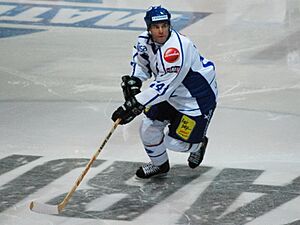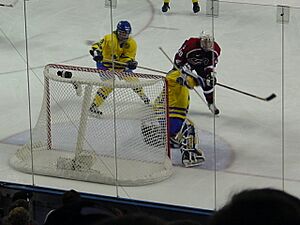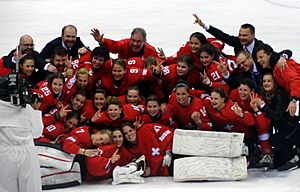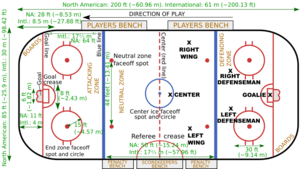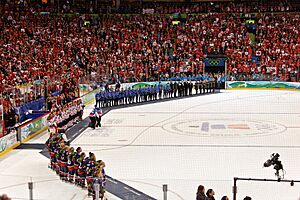Ice hockey at the Olympic Games facts for kids
Quick facts for kids Ice hockey at the Olympic Games |
|
|---|---|
 |
|
| Governing body | IIHF |
| Events | 2 (men: 1; women: 1) |
| Games | |
|
|
|
|
Ice hockey has been a thrilling sport at the Olympic Games for a long time! The men's tournament first appeared at the 1920 Summer Olympics. It then moved to the Winter Olympic Games in 1924, where it has been ever since. Women's ice hockey joined the Olympics later, making its debut at the 1998 Winter Olympics.
For many years, only amateur athletes were allowed to compete in the Olympics. But as sports changed, the rules did too. By 1998, even professional players from the National Hockey League (NHL) were allowed to join the fun! This meant the best players in the world could compete for their countries. The NHL paused its season for the Olympics from 1998 to 2014. After skipping the 2018 and 2022 Games, NHL players are expected to return for the 2026 Olympics and beyond.
The rules for Olympic ice hockey are set by the International Ice Hockey Federation (IIHF). These rules are a bit different from the ones used in the NHL. In the men's tournament, Canada was super strong early on, winning six gold medals between 1920 and 1952. Later, the Soviet Union became the team to beat, winning seven gold medals. The United States had a famous win in 1980, known as the "Miracle on Ice", when they beat the powerful Soviet team. Canada won gold again in 2002, 2010, and 2014. Other countries like Great Britain, Sweden, the Czech Republic, Russia, and Finland have also won gold medals.
In women's ice hockey, the Canadian team has been very dominant. They have won most of the gold medals since the sport was added. The United States won the first women's tournament in 1998 and again in 2018.
Contents
How Ice Hockey Joined the Olympics
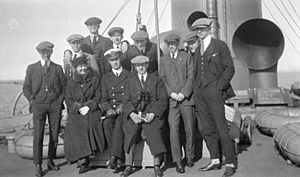
The very first Olympic ice hockey tournament happened at the 1920 Summer Olympics in Antwerp, Belgium. Back then, international ice hockey was quite new. The International Ice Hockey Federation (IIHF), which is the main group that runs the sport, was formed in 1908.
Ice hockey was added to the list of possible Olympic sports in 1914. The decision to include it for the 1920 Summer Olympics was made just three months before the Games started! One reason it was included was that five European countries wanted to play. Also, the arena in Antwerp said they would only let figure skating happen there if ice hockey was also part of the Games.
The IIHF considers the 1920 tournament to be the first Ice Hockey World Championship. For many years, until 1968, the Olympic hockey tournament also counted as the World Championship for that year.
The first Winter Olympic Games were held in 1924 in Chamonix, France. Ice hockey and figure skating became permanent parts of the Winter Olympics. The Winter Games were held in the same year as the Summer Games until 1992. After that, they started happening every four years, but two years after the Summer Games (like in 1994, 1998, and so on).
Men's Tournament History
Early Games: 1920–1936
The men's tournament at the 1920 Summer Olympics had a special system for awarding medals. First, teams played to find the gold medal winner. Then, the teams that lost to the gold winner played for the silver medal. Finally, teams that lost to either the gold or silver winners played for the bronze.
Seven teams played in 1920, including Canada, the United States, and Sweden. Canada sent the Winnipeg Falcons, who were very strong. They won all their games and took home the gold medal, beating Sweden 27–1! The United States won silver, and Czechoslovakia won bronze. This medal system was a bit confusing and was not used again for ice hockey.
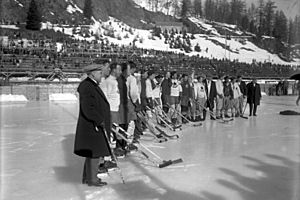
In 1924, the tournament changed to a round-robin format, where teams played each other. This format was used until 1988. Canada's team, the Toronto Granites, was incredibly dominant, scoring 110 goals and only letting in 3! They were led by Harry Watson, who scored 36 goals. The United States won silver, and Great Britain won bronze.
At the 1928 Winter Olympics in Switzerland, Canada won gold again without letting in a single goal. Sweden and Switzerland won their first medals, silver and bronze. In 1932, Canada won gold again. Germany won their first medal, a bronze.
At the 1936 Winter Olympics, there was a small argument about whether some British players were truly amateurs. Despite this, Great Britain became the first non-Canadian team to win gold. Canada won silver, and the United States won bronze.
The Amateur Rule and Soviet Dominance: 1948–1976
For many years, the Olympics were only for amateur athletes. This meant professional players, like those from the NHL, were not allowed to play. However, some countries, especially from the Eastern Bloc, had "full-time amateur athletes" who were paid by the state to train. This made it hard for Western countries whose players had to pay for themselves.
In 1948, there was a big debate about which American team could play because of the amateur rules. In the end, a team was allowed to play, but their games didn't officially count for the Olympic medals. Canada won gold, and Czechoslovakia won silver.

The Soviet Union joined the Olympics in 1956 and quickly became the top team. They won seven of the next nine tournaments. The United States had a surprise gold medal win in 1960.
In 1970, Canada stopped playing in international hockey because they felt it was unfair that the Soviet Union and Czechoslovakia used full-time "amateurs." Canada did not participate in the 1972 and 1976 Olympics. The Soviet team, led by star goalie Vladislav Tretiak, continued to win gold in 1972 and 1976.
The "Miracle on Ice" and NHL Players Join: 1980–2014
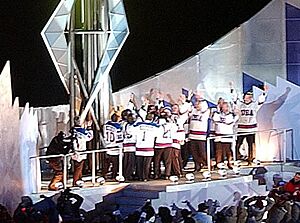
The 1980 Winter Olympics in Lake Placid, USA, saw one of the most famous moments in sports history: the "Miracle on Ice". The Soviet Union team was expected to win easily, as they had many experienced players. But the young American team, made up of college players, pulled off a huge upset, beating the Soviets 4–3. The U.S. then went on to win the gold medal by beating Finland. This victory is still celebrated as one of the greatest Olympic moments.
The Soviet Union won gold again in 1984 and 1988. In 1986, the International Olympic Committee (IOC) decided to allow professional athletes to compete in the Olympics. This was a big change!
The Soviet Union broke up in 1991. At the 1992 Winter Olympics, several former Soviet states played together as the Unified Team and won gold. In 1994, Sweden won its first gold medal in a thrilling shootout against Canada.
In 1995, an agreement was made to allow NHL players to participate in the Olympics. This meant the best hockey players in the world could finally represent their countries. The 1998 tournament in Nagano, Japan, was the first with NHL players. The Czech Republic, led by amazing goalie Dominik Hašek, surprised everyone by winning gold.
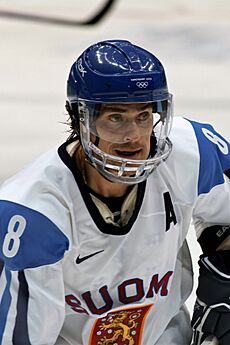
At the 2002 Winter Olympics in Salt Lake City, Canada won its first gold medal in 50 years, beating the United States in the final. In 2006, Sweden won gold, becoming the first team to win both the Olympic and World Championship gold in the same year.

The 2010 Winter Olympics were held in Vancouver, Canada. Teemu Selänne of Finland set a new record for most points in the men's tournament. In a very exciting gold medal game, Canada beat the United States 3–2 in overtime, with Sidney Crosby scoring the winning goal. Canada won gold again in 2014 in Sochi, Russia, beating Sweden 3–0. They didn't lose a single game in that tournament!
Recent Games: 2018–2022
The 2018 Winter Olympics in PyeongChang, South Korea, did not have NHL players. This was the first time since 1994. The Olympic Athletes from Russia won the gold medal, beating Germany in overtime. Canada won the bronze.
For the 2022 Winter Olympics in Beijing, China, NHL players were again not allowed to participate due to the COVID-19 pandemic. Finland won their first-ever ice hockey gold medal, going undefeated and beating the Russian Olympic Committee in the final. Slovakia won their first bronze medal.
Women's Tournament History
Joining the Olympics: 1998–2006

In 1992, the IOC decided to add women's hockey to the Olympics, starting with the 1998 Winter Olympics in Nagano, Japan. The organizers in Nagano were a bit worried about the extra costs, but they agreed to include it with a limit of six teams and no new buildings needed.
Before 1998, Canada had won every World Championship. However, by 1997, the American team had become very strong. In the 1998 Olympic tournament, Canada and the United States were the top teams. They met in the final, and the United States won 3–1, taking the first women's Olympic gold medal. Finland won the bronze.
For the 2002 Winter Olympics, more teams were added. Canada and the United States again reached the final, with Canada winning 3–2 this time. Sweden won their first medal in women's hockey, a bronze. In 2006, Sweden surprised everyone by beating the United States in the semi-finals. Canada then defeated Sweden 4–1 to win their second gold medal in a row.
Continued Growth: 2010–2022
In 2010, Canada won their third gold medal in a row, beating the United States 2–0. Finland won the bronze medal.
There was some talk about whether women's hockey should stay in the Olympics because Canada and the United States were so dominant. But leaders in hockey promised to help other countries improve their teams.
At the 2014 Winter Olympics, Canada won their fourth gold medal in a row, beating the United States 3–2 in overtime after coming back from a two-goal deficit. Canadian players Hayley Wickenheiser, Jayna Hefford, and Caroline Ouellette became the first athletes to win four ice hockey gold medals. Switzerland won their first women's hockey medal, a bronze.
In 2018, the United States won gold again, beating Canada in a shootout. This was their first gold in 20 years.
The 2022 tournament had ten teams for the first time. Canada won their fifth gold medal, defeating the United States 3–2 in the final. Finland won the bronze medal.
Rules of the Game
How Teams Qualify
Since 1976, usually 12 teams play in the men's tournament. For the 1998 and 2002 Olympics, 14 teams played. The top teams in the world, like Canada, USA, Russia, Sweden, Finland, and the Czech Republic, usually get to play automatically. Other teams have to play in special qualification tournaments to earn their spot.
The women's tournament has a similar way of qualifying. The top six teams in the world usually get automatic spots, and other teams play in qualification rounds.
Player Eligibility
To play in international hockey tournaments, a player must be part of their country's national hockey association. They must also be a citizen of the country they want to play for. If a player changes their citizenship, they usually have to play in their new country's national games for at least two years before they can play for that country's national team.
Professional Players in the Olympics
For a long time, the Olympics were only for amateur athletes. This idea came from a time when sports were seen as a hobby for gentlemen, not a job. But as sports changed, this rule became harder to follow. Some countries had athletes who were called "amateurs" but were actually paid by their governments to train full-time. This put other countries at a disadvantage.
Canada pushed for professional players to be allowed in the Olympics. After many discussions, the IOC finally voted in 1986 to allow all athletes, including professionals, to compete starting in 1988.

The National Hockey League (NHL) didn't allow its players to go to the Olympics at first because the Games happen during their regular season. But after seeing how popular professional basketball players were at the 1992 Summer Olympics, the NHL decided to let its players go. In 1995, an agreement was made for NHL players to join the Olympics starting in 1998. This was a big deal for hockey fans!
NHL players participated from 1998 to 2014. However, the NHL decided not to send its players to the 2018 and 2022 Olympics. This was partly because of concerns about player injuries and the cost of stopping their season. Many players were disappointed, as they love representing their countries. For example, Russian NHL star Alexander Ovechkin said he would play for Russia even if the NHL didn't allow it. However, players had to follow the league's decision. NHL players are expected to return for the 2026 Olympics.
Game Rules
The first Olympic hockey tournament in 1920 had different rules. Games were played outdoors, and forward passes were not allowed. Teams had seven players on the ice, including a "rover." After that, the IIHF adopted Canadian rules: six players per side and three periods.
Olympic hockey follows IIHF rules, which are a bit different from NHL rules. For example, international rinks are wider than NHL rinks. This allows for a faster game with less physical contact. Also, the rules for "icing" (when a player shoots the puck all the way down the ice) are different. In IIHF games, play stops as soon as the puck crosses the goal line, while in the NHL, players race to the puck.
Players are required to wear helmets since 1970, and goalies must wear masks since 1972. In 1992, the IIHF started using a playoff system to decide medal winners, and tie games in the medal round are decided by a shootout.
Each team can have between 15 and 20 skaters (forwards and defensemen) and two or three goalies. All players must be citizens of the country they play for.
Fair Play: Banned Substances
The IIHF follows rules from the World Anti-Doping Agency (WADA) to make sure athletes don't use performance-enhancing drugs. Top players are regularly tested for banned substances. If a player tests positive, they can be disqualified and suspended. If a team has multiple positive tests, the whole team can be disqualified. These rules help keep the competition fair and safe for everyone.
Results
Men's Tournament Summary
| # | Year | Hosts | Gold medal game | Bronze medal game | ||||
|---|---|---|---|---|---|---|---|---|
| Gold | Score | Silver | Bronze | Score | Fourth place | |||
| 1 | 1920 Details |
Antwerp |
Canada |
2–0 | United States |
Czechoslovakia |
1–0 | Sweden |
| 2 | 1924 Details |
Chamonix |
Canada |
round-robin | United States |
Great Britain |
round-robin | Sweden |
| 3 | 1928 Details |
St. Moritz |
Canada |
round-robin | Sweden |
Switzerland |
round-robin | Great Britain |
| 4 | 1932 Details |
Lake Placid |
Canada |
round-robin | United States |
Germany |
round-robin | Poland |
| 5 | 1936 Details |
Garmisch-Partenkirchen |
Great Britain |
round-robin | Canada |
United States |
round-robin | Czechoslovakia |
| 6 | 1948 Details |
St. Moritz |
Canada |
round-robin | Czechoslovakia |
Switzerland |
round-robin | Sweden |
| 7 | 1952 Details |
Oslo |
Canada |
round-robin | United States |
Sweden |
round-robin | Czechoslovakia |
| 8 | 1956 Details |
Cortina d'Ampezzo |
Soviet Union |
round-robin | United States |
Canada |
round-robin | Sweden |
| 9 | 1960 Details |
Squaw Valley |
United States |
round-robin | Canada |
Soviet Union |
round-robin | Czechoslovakia |
| 10 | 1964 Details |
Innsbruck |
Soviet Union |
round-robin | Sweden |
Czechoslovakia |
round-robin | Canada |
| 11 | 1968 Details |
Grenoble |
Soviet Union |
round-robin | Czechoslovakia |
Canada |
round-robin | Sweden |
| 12 | 1972 Details |
Sapporo |
Soviet Union |
round-robin | United States |
Czechoslovakia |
round-robin | Sweden |
| 13 | 1976 Details |
Innsbruck |
Soviet Union |
round-robin | Czechoslovakia |
West Germany |
round-robin | Finland |
| 14 | 1980 Details |
Lake Placid |
United States |
round-robin | Soviet Union |
Sweden |
round-robin | Finland |
| 15 | 1984 Details |
Sarajevo |
Soviet Union |
round-robin | Czechoslovakia |
Sweden |
round-robin | Canada |
| 16 | 1988 Details |
Calgary |
Soviet Union |
round-robin | Finland |
Sweden |
round-robin | Canada |
| 17 | 1992 Details |
Albertville |
Unified Team |
3–1 | Canada |
Czechoslovakia |
6–1 | United States |
| 18 | 1994 Details |
Lillehammer |
Sweden |
3–2 SO | Canada |
Finland |
4–0 | Russia |
| 19 | 1998 Details |
Nagano |
Czech Republic |
1–0 | Russia |
Finland |
3–2 | Canada |
| 20 | 2002 Details |
Salt Lake City |
Canada |
5–2 | United States |
Russia |
7–2 | Belarus |
| 21 | 2006 Details |
Torino |
Sweden |
3–2 | Finland |
Czech Republic |
3–0 | Russia |
| 22 | 2010 Details |
Vancouver |
Canada |
3–2 OT | United States |
Finland |
5–3 | Slovakia |
| 23 | 2014 Details |
Sochi |
Canada |
3–0 | Sweden |
Finland |
5–0 | United States |
| 24 | 2018 Details |
Pyeongchang |
Olympic Athletes from Russia |
4–3 OT | Germany |
Canada |
6–4 | Czech Republic |
| 25 | 2022 Details |
Beijing |
Finland |
2–1 | ROC |
Slovakia |
4–0 | Sweden |
Men's Medal Table
Updated after the 2022 Winter Olympics.
| Rank | Nation | Gold | Silver | Bronze | Total |
|---|---|---|---|---|---|
| 1 | 9 | 4 | 3 | 16 | |
| 2 | 7 | 1 | 1 | 9 | |
| 3 | 2 | 8 | 1 | 11 | |
| 4 | 2 | 3 | 4 | 9 | |
| 5 | 1 | 2 | 4 | 7 | |
| 6 | 1 | 0 | 1 | 2 | |
| 1 | 0 | 1 | 2 | ||
| 8 | 1 | 0 | 0 | 1 | |
| 1 | 0 | 0 | 1 | ||
| 10 | 0 | 4 | 4 | 8 | |
| 11 | 0 | 1 | 1 | 2 | |
| 0 | 1 | 1 | 2 | ||
| 13 | 0 | 1 | 0 | 1 | |
| 14 | 0 | 0 | 2 | 2 | |
| 15 | 0 | 0 | 1 | 1 | |
| 0 | 0 | 1 | 1 | ||
| Totals (16 entries) | 25 | 25 | 25 | 75 | |
Women's Tournament Summary
| # | Year | Hosts | Gold medal game | Bronze medal game | ||||
|---|---|---|---|---|---|---|---|---|
| Gold | Score | Silver | Bronze | Score | Fourth place | |||
| 1 | 1998 Details |
Nagano |
United States |
3–1 | Canada |
Finland |
4–1 | China |
| 2 | 2002 Details |
Salt Lake City |
Canada |
3–2 | United States |
Sweden |
2–1 | Finland |
| 3 | 2006 Details |
Torino |
Canada |
4–1 | Sweden |
United States |
4–0 | Finland |
| 4 | 2010 Details |
Vancouver |
Canada |
2–0 | United States |
Finland |
3–2 OT | Sweden |
| 5 | 2014 Details |
Sochi |
Canada |
3–2 OT | United States |
Switzerland |
4–3 | Sweden |
| 6 | 2018 Details |
Pyeongchang |
United States |
3–2 SO | Canada |
Finland |
3–2 | Olympic Athletes from Russia |
| 7 | 2022 Details |
Beijing |
Canada |
3–2 | United States |
Finland |
4–0 | Switzerland |
Women's Medal Table
Updated after the 2022 Winter Olympics.
| Rank | Nation | Gold | Silver | Bronze | Total |
|---|---|---|---|---|---|
| 1 | 5 | 2 | 0 | 7 | |
| 2 | 2 | 4 | 1 | 7 | |
| 3 | 0 | 1 | 1 | 2 | |
| 4 | 0 | 0 | 4 | 4 | |
| 5 | 0 | 0 | 1 | 1 | |
| Totals (5 entries) | 7 | 7 | 7 | 21 | |
Overall Medal Table
Updated after the 2022 Winter Olympics.
| Rank | Nation | Gold | Silver | Bronze | Total |
|---|---|---|---|---|---|
| 1 | 14 | 6 | 3 | 23 | |
| 2 | 7 | 1 | 1 | 9 | |
| 3 | 4 | 12 | 2 | 18 | |
| 4 | 2 | 4 | 5 | 11 | |
| 5 | 1 | 2 | 8 | 11 | |
| 6 | 1 | 0 | 1 | 2 | |
| 1 | 0 | 1 | 2 | ||
| 8 | 1 | 0 | 0 | 1 | |
| 1 | 0 | 0 | 1 | ||
| 10 | 0 | 4 | 4 | 8 | |
| 11 | 0 | 1 | 1 | 2 | |
| 0 | 1 | 1 | 2 | ||
| 13 | 0 | 1 | 0 | 1 | |
| 14 | 0 | 0 | 3 | 3 | |
| 15 | 0 | 0 | 1 | 1 | |
| 0 | 0 | 1 | 1 | ||
| Totals (16 entries) | 32 | 32 | 32 | 96 | |
See also
 In Spanish: Hockey sobre hielo en los Juegos Olímpicos para niños
In Spanish: Hockey sobre hielo en los Juegos Olímpicos para niños



